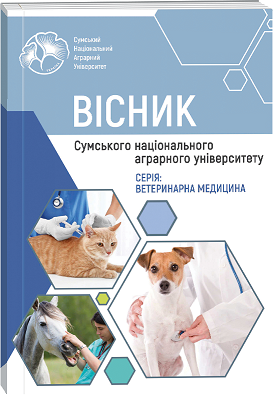SENSITIVITY OF THE SKIN MICROFLORA OF DOGS WITH DERMATITIS TO ANTIBIOTICS
Abstract
In the paper, an analysis of samples of pathological material from sick dogs was carried out, which testified to the heterogeneity of the microbiota for dermatitis in dogs. Thus, in the vast majority of cases, polyinfection was identified, in three cases out of five, and in two cases, mono. It should be noted that Staphylococcus aureus was always present in the association of pathogens. The study of the sensitivity of the isolated microflora to antibacterial drugs of 8 groups by the disc method made it possible to obtain heterogeneous results. Thus, 5% of the microbiota was highly sensitive to almost all antibiotics of this group to the drugs of the fluoroquinolone group – marfloxin, ofloxacin, cyprocoline and enroxyl. And only Pseudomonas aeruginosa is sensitive in sample 5 and in the second sample due to its association with Staphylococcus aureus. The microbiota showed varying sensitivity to cephalosporin drugs, from moderately sensitive to highly sensitive. Thus, microflora was sensitive to ceftriaxone in the first sample and Pseudomonas aeruginosa in the second in association with Staphylococcus aureus and in 5 when only Pseudomonas aeruginosa was isolated. When studying sensitivity to cobactan, it was established that in the first and fourth samples, Staphylococcus aureus showed high sensitivity to it and was sensitive to it. In addition, Staphylococcus aureus sample three and Pseudomonas aeruginosa sample five were highly sensitive to the drug. Growth retardation (from 18 mm) to ceftifur indicated that Enterococcus faecalis was sensitive in the first and fourth samples and Pseudomonas aeruginosa in the second and fifth. At the same time, Staphylococcus aureus showed high sensitivity in the first, second, third and fourth samples (growth delay 27 mm). Staphylococcus aureus was highly sensitive to cefataxime in the second sample, while Pseudomonas aeruginosa was moderately sensitive. When studying sensitivity to cephalexin, we found that in the second sample, the isolated association of Staphylococcus aureus with Pseudomonas aeruginosa had growth retardation from 17 first and 11 second pathogens. In the fourth sample for the association of Staphylococcus aureus and Enterococcus faecalis, the lysis zone was larger in the second pathogen (from 19 mm) compared to 12 mm in the first. The zone of growth retardation in the fifth sample indicated the sensitivity of Pseudomonas aeruginosa to this antibiotic.
References
2. Abdallah, F., Mijouin, L., & Pichon, C. (2017). Skin Immune Landscape: Inside and Outside the Organism. Mediators of inflammation, 2017, 5095293. https://doi.org/10.1155/2017/5095293
3. Chambers, E. S., & Vukmanovic-Stejic, M. (2020). Skin barrier immunity and ageing. Immunology, 160(2), 116–125. https://doi.org/10.1111/imm.13152
4. Díaz-Regañón, D., Sainz, Á., Rodríguez-Franco, F., Villaescusa, A., Olmeda, P., Morcillo, A., & García-Sancho, M. (2023). Assessing the Quality of Life of Dogs with Inflammatory Bowel Disease and Their Owners. Veterinary sciences,10(7), 405. https://doi.org/10.3390/vetsci10070405
5. Gallo R. L. (2017). Human Skin Is the Largest Epithelial Surface for Interaction with Microbes. The Journal of investigative dermatology, 137(6), 1213–1214. https://doi.org/10.1016/j.jid.2016.11.045
6. Gedon, N. K. Y., & Mueller, R. S. (2018). Atopic dermatitis in cats and dogs: a difficult disease for animals and owners. Clinical and translational allergy, 8, 41. https://doi.org/10.1186/s13601-018-0228-5).
7. Hargis, A. M., & Myers, S. (2017). The Integument. Pathologic Basis of Veterinary Disease, 1009–1146.e1. https://doi.org/10.1016/B978-0-323-35775-3.00017-5
8. Kotnik T. (2023). Quality of Life of Allergic Dogs Treated with Allergen-Specific Immunotherapy-A Retrospective Study. Veterinary sciences, 10(2), 72. https://doi.org/10.3390/vetsci10020072
9. Meason-Smith, C., Diesel, A., Patterson, A. P., Older, C. E., Mansell, J. M., Suchodolski, J. S., & Rodrigues Hoffmann, A. (2015). What is living on your dog's skin? Characterization of the canine cutaneous mycobiota and fungal dysbiosis in canine allergic dermatitis. FEMS microbiology ecology, 91(12), fiv139. https://doi.org/10.1093/femsec/fiv139
10. Nødtvedt, A., Bergvall, K., Emanuelson, U., & Egenvall, A. (2006). Canine atopic dermatitis: validation of recorded diagnosis against practice records in 335 insured Swedish dogs. Acta veterinaria Scandinavica, 48(1), 8. https://doi.org/10.1186/1751-0147-48-8
11. Outerbridge, C. A., & Jordan, T. J. M. (2021). Current Knowledge on Canine Atopic Dermatitis: Pathogenesis and Treatment. Advances in small animal care, 2, 101–115. https://doi.org/10.1016/j.yasa.2021.07.004

 ISSN
ISSN  ISSN
ISSN 



